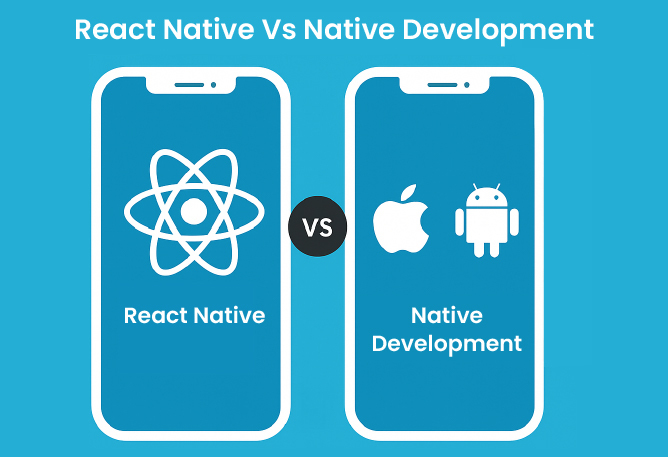As mobile developers—especially those early in your careers—you face a critical decision: whether to build with React Native or pursue platform-specific native development. Each path has its trade-offs, from speed and cost to performance and feature access. In 2025, knowing these differences and aligning them with your project goals, team skills, and timeline is key to delivering successful apps efficiently.
What Is React Native vs Native Development
What Is React Native?
React Native is an open-source cross-platform framework developed by Meta, enabling developers to create apps for both iOS and Android from a single JavaScript/React codebase. This approach saves time and resources by allowing one team to work across platforms. It uses native UI components, so the end result feels close to a native app in look and performance.
- Shared codebase reduces duplication of effort
- Hot reloading accelerates the development process.
- Strong community support provides plenty of reusable components
What Is Native Development?
Native development involves building separate apps for each platform with official languages and tools—Swift/Objective-C for iOS and Kotlin/Java for Android. This method delivers the best possible performance, stability, and integration with device features. It requires more resources but allows deep customization and immediate access to the latest platform capabilities.
- Direct access to platform-specific APIs and hardware
- Optimal performance for demanding apps like games or multimedia
- Richer, platform-consistent UI and UX experiences
Why Teams Must Understand the Trade-Offs
Development Speed & Cost
- React Native enables rapid development through a unified codebase plus hot reloading—ideal for quick MVPs and tight deadlines. It can reduce costs by 30–35%
- Native demands separate development efforts for each platform, increasing both time and expense
Performance & UI/UX Fidelity
- Native apps typically deliver smoother animations and deeper integration with system components—a must for complex UI or performance-critical apps
- React Native has come a long way—its New Architecture (Fabric, JSI) narrows the performance gap—but still may fall short on highly specialized or graphic-intensive tasks
Scalability & Maintenance
- React Native allows feature reuse and simpler maintenance from a single codebase
- Native development, though more complex to maintain, offers direct access to the latest APIs and platform tools—and better long-term support
When to Choose Which: Developer Perspective
Pick React Native if:
- You’re building an MVP or need fast cross-platform entry
- Budget and team size are limited
- UI needs are moderate and can be met with existing components
Choose Native if:
- You’re developing a performance-heavy or highly interactive app
- You need access to cutting-edge platform features as soon as they’re released
- You’re focused on delivering a finely-tuned, platform-specific UI
Conclusion
React Native offers efficiency, lower cost, and quick deployment—perfect for startups and simpler apps. Native development provides unmatched performance, control, and future-proofing—ideal for feature-rich, high-demand applications. Ultimately, your choice must align with project complexity, team skills, and long-term vision.






















